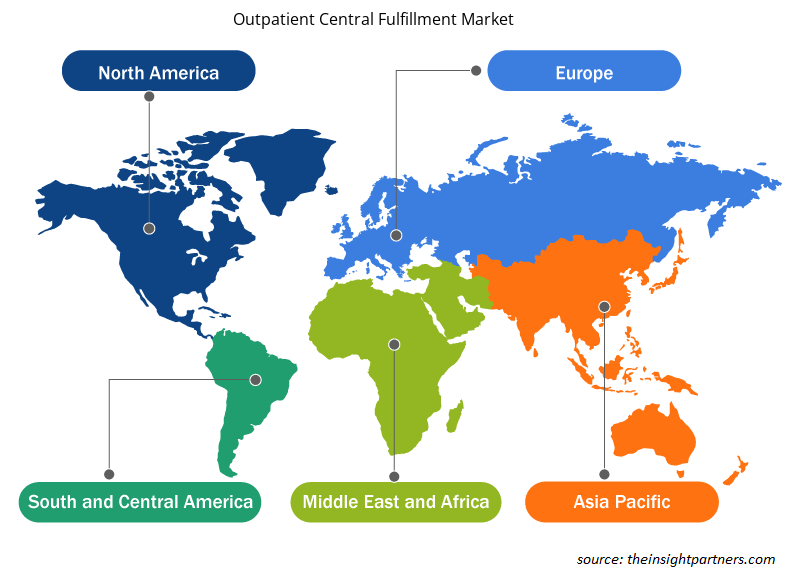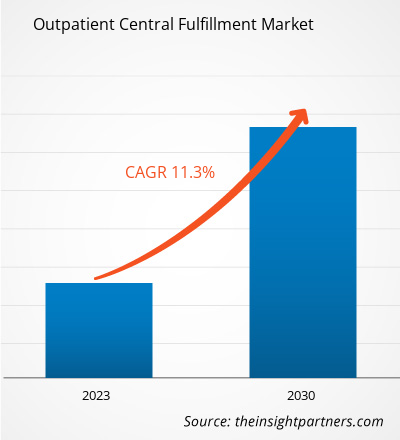[研究报告] 门诊中央履行市场规模预计将从 2022 年的 3.0932 亿美元激增至 2030 年的 7.2579 亿美元;预计 2022-2030 年期间市场复合年增长率 为11.3%。
分析师观点:
任何药房流程的机械程序自动化通常需要跟踪和更新数据库中的客户信息(例如,病史和药物相互作用风险检测)、计数小物体(例如,药丸和胶囊)、测量和混合粉末和液体以进行汇编等活动。因此,许多医院和药房都偏爱自动化药房。医院使用药房自动化来改善患者护理并实现长期财务节省。例如,医院药房自动执行测量液体或粉末进行混合的任务,以简化和自动化医疗保健药物处理。全球药房整合自动化服务已显着提高了处方药储存、分配、填充、包装和标签的有效性和安全性。此外,填写和标记处方会产生药物浪费;通过药房自动化可以最大限度地减少这种浪费。因此,传统药房也已开始向自动化系统过渡。因此,预计这些因素将影响全球门诊中央履行市场的增长
市场概况:
由于消费者对药品的需求增加、制药公司之间的竞争加剧、技术进步以及精密机器人设备的可用性,药房自动化行业正在增长。对无错误药物的需求不断增长,预计将推动门诊集中履行市场的发展。许多国家的政府都在药房和医院推广自动化用药技术,以减少处方和配药错误。因此,门诊集中履行越来越受欢迎。然而,医疗保健组织不愿支持门诊集中处理,这可能会在一定程度上阻碍整个市场的增长。严格的监管控制和大量的初始投资要求也限制了门诊集中履行市场的增长。
主要参与者的技术进步有利于门诊中央配送市场的增长。2021 年 9 月,Deenova报告赢得了其在德国的首份合同,并在欧洲最大的 GDP 医疗保健市场同时建立了Deenova业务。根据这份合同,该公司将在Marien Hospital Gelsenkirchen交付和安装 3 台一体式包装机器人、34 台一体式站位药物分配机器人和 72 辆带有安全床边验证的一体式手推车。它还将为这些解决方案提供全方位服务支持。Marien Hospital Gelsenkirchen是 St. Augustinus Gelsenkirchen GmbH服务网络中的一家运营公司。
定制此报告以满足您的需求
您可以免费定制任何报告,包括本报告的部分内容、国家级分析、Excel 数据包,以及为初创企业和大学提供优惠和折扣
- 获取此报告的关键市场趋势。这个免费样品将包括数据分析,从市场趋势到估计和预测。
市场驱动因素和限制因素:
药房自动化已成为医疗保健行业最繁荣的领域之一。自动化技术可以通过自动化药房任务和流程来改善患者护理并提高效率。根据 Visionary Insights 的一项研究,到 2021 年,药房的自动化程度预计将增长 22%。这一增长可能是由于对精确高效配药的需求不断增长,以及特殊药物配药操作的数量不断增加。药剂师还采用技术来自动化配药以外的某些其他任务, 例如库存管理。自动化库存系统可以帮助药房更准确地跟踪和管理其库存,这有望促进门诊中央履行市场的增长。
2021 年 2 月,Omnicell Inc. 宣布推出 Medimat,这是一款面向零售药店的下一代自动配药系统。该系统旨在提高患者安全性、高效利用时间和节省资金。同样,innovativeAspirations (iA) 是一家软件支持的药房履行和自动化解决方案的商业提供商,于 2021 年 8 月推出了 3 种与 Medimat 的 NEXiA 技术集成的解决方案,以集中管理处方药的履行。iA 还推出了 SmartPod,这是一款带有模块化自动填充装置的下一代机器人。市场参与者的此类策略预计将推动门诊中央履行市场的发展。
常见的用药错误可能会对患者造成伤害,包括配错药、配错药量和配错药量。此外,无意中遗漏物品也可能导致用药错误。这些错误令人担忧,被认为是全球第三大死亡原因。世界卫生组织 (WHO) 还指出,用药错误导致全球每 100 万人口中就有 1 人死亡。不安全的医疗实践给医疗保健行业带来了不可避免的风险。根据美国食品药品管理局 (FDA) 的数据,每年收到超过 100,000 份与用药错误相关的报告。分心是导致用药错误的主要原因。分心是因为医疗保健专业人员全天从事多项任务,包括检查患者、与顾问互动、与患者家属交谈以及与保险专业人员交谈。有时,急于完成职责会导致判断失误,这可能会导致用药错误。用药错误的另一个主要原因是扭曲。书写不当、缩写、误解的符号或不正确的翻译都会导致信息失真。因此,不可否认的用药错误可能性推动了门诊集中配送市场的增长。
尽管药房运营自动化具有明显优势,但医生和医疗服务提供者对采用自动化仍存在抵触情绪。这种抵触情绪主要是由于文化障碍,尤其是在新兴市场。自动化药房主要受到高容量药剂师和医疗机构的欢迎,这些机构可以通过实施此类自动化系统实现投资回报 (ROI)。据 Rangewell 称,药房自动化成本从 54,710.50 美元到 547,105 美元及以上不等;此外,该价值仅基于系统的物理价格。此外,维护和维修成本增加了药房自动化系统的总成本。自动配药系统需要定期更新软件才能正常运行,这是一个昂贵的过程。药房老板经常担心药物配药的安全性和准确性,因为存在交叉污染的风险。由于机器被编程为管理不同的药物,因此机器人中可能会残留微量的药物。因此,必须定期进行彻底清洁,以避免交叉污染。医护人员需要对这些系统进行编程,任何药物输入错误都可能导致用药错误,影响患者的整体健康。此外,这些系统无法自行补充药物;必须有操作员在场检查库存是否充足。因此,与自动配药系统相关的高资本要求和运营限制阻碍了门诊中央配送市场的增长。
节段分析:
根据产品类型,门诊中央配送市场分为自动药物分配系统、自动包装和标签系统、自动台式计数器、自动存储和检索系统以及其他类型。自动药物分配系统部分在 2022 年占据了最大的门诊中央配送市场份额,预计在 2022-2030 年期间将实现 12.0% 的最高复合年增长率。自动药物分配系统或自动药柜是一种电子设备,主要用于医疗保健环境中的药物储存和分配。这些系统使用经过验证的密码和生物识别技术进行药品库存控制和安全保护,有助于跟踪和控制药品分配。这些系统现在广泛应用于许多医院、诊所和疗养院。BD 提供的 Pyxis MedStation 系统是世界上使用最广泛的自动分配系统之一。它支持分散式药物管理,其条形码扫描可确保准确的药物分配。
根据最终用户,门诊中央配送市场细分为医院药房、零售药房和 邮购药房。医院药房部门在 2022 年占据了最大的门诊中央配送市场份额。预计该细分市场的市场在 2022-2030 年期间将以最高复合年增长率增长。许多医院采用药房自动化系统来确保准确性、可重复性和患者安全。一些研究发现医院药房的人工错误率高达 10%。许多研究证明,使用 ADM 带来的好处多于责任。2020 年 3 月,Swisslog Healthcare 与 PipelineRx 和 Savioke 合作推出了 Meds-to-Beds 计划,该计划旨在为医院门诊患者出院时提供药房服务。该计划包括自动机器人配送处方药和咨询以扩大药房容量。由于医院药房认识到需要为患者提供高标准的护理,预测期内对自动化设备的需求可能会大幅增加。
区域分析:
北美是门诊中央配送市场的主导地区。2022 年北美门诊中央配送市场预测价值为 1.5256 亿美元,预计到 2030 年将达到 3.505 亿美元;预计 2022-2030 年期间的复合年增长率为 11.0%。北美门诊中央配送市场分为美国、加拿大和墨西哥。该地区门诊中央配送市场的增长归因于美国药房自动化的采用率不断提高、公共卫生意识不断增强、政府战略举措激增以及领先药房自动化供应商的存在。美国是北美门诊中央配送市场的最大贡献者。随着药房负担的增加,该国用药错误的发生率也在增加。美国门诊中央配送市场份额主要归因于医疗专业人员对用药错误激增和对药品需求增加的担忧日益增加。 Capsa Healthcare 总部位于美国波特兰,专注于开发药物推车、电脑推车、医疗推车、壁挂式工作站和处方药计数器。2023 年 7 月,该公司收购了 MASS Medical Storage。收购 MASS Medical Storage 使 Capsa 获得了制造医疗存储和内窥镜柜干燥系统的专业知识。2021 年,Rx Billing Genie, LP 推出了 Rx Billing Genie 应用程序。该公司与加拿大药剂师协会的合作推动了 Rx Billing Genie 应用程序在全国范围内的采用。在墨西哥,医疗旅游业的发展导致药品处方激增,为门诊中央配送市场提供了重要的增长机会。
欧洲拥有第二大门诊中央履行市场份额。该地区在全球门诊中央履行市场中占有相当大的份额。众多国内市场参与者的存在和慢性病发病率的上升是该地区市场受益的主要因素之一。德国是全球门诊中央履行市场的主要贡献者之一。该国有许多参与者致力于开发和制造医疗设备以及医疗保健行业所需的配件。此外,法国、西班牙、意大利、爱尔兰和荷兰的医疗保健行业发展速度更快,展示了创新医疗处方和配药技术的进步。
预计 2022-2030 年期间,亚太地区门诊集中配送市场将以 12.1% 的最高复合年增长率增长。推动该地区市场发展的因素包括国际参与者进入医疗保健市场以及老年人口的增加。此外,传染病和慢性病病例激增以及政府和非政府组织的举措推动了亚太地区门诊集中配送市场的增长。医疗旅游进一步促进了亚太地区医院行业的蓬勃发展,进而引发了用药错误的发生率。根据 LEK Consulting 发布的一项调查,亚洲国家约 65% 的医院增加了数字化支出,以减少用药错误。
关键球员分析:
Capsa Healthcare、Cardinal Health、Surescripts、McKesson Corporation、Tension Packaging and Automation、ScriptPro LLC、Omnicell、BD、RxSafe LLC 和 Custom Health Inc. 是市场研究期间分析的主要门诊中央履行参与者。由于其多样化的产品组合,Capsa Healthcare 和 Omnicell 是门诊中央履行市场中的前两大参与者。
门诊中央履行市场区域洞察
Insight Partners 的分析师已详细解释了预测期内影响门诊中央履行市场的区域趋势和因素。本节还讨论了北美、欧洲、亚太地区、中东和非洲以及南美洲和中美洲的门诊中央履行市场细分和地理位置。

- 获取门诊中央履行市场的区域特定数据
门诊中央履行市场报告范围
| 报告属性 | 细节 |
|---|---|
| 2022 年市场规模 | 3.0932亿美元 |
| 2030 年市场规模 | 7.2579亿美元 |
| 全球复合年增长率(2022 - 2030 年) | 11.3% |
| 史料 | 2020-2021 |
| 预测期 | 2023-2030 |
| 涵盖的领域 | 按产品类型
|
| 覆盖地区和国家 | 北美
|
| 市场领导者和主要公司简介 |
|
市场参与者密度:了解其对商业动态的影响
门诊中央配送市场正在快速增长,这得益于终端用户需求的不断增长,这些需求源于消费者偏好的不断变化、技术进步以及对产品优势的认识不断提高等因素。随着需求的增加,企业正在扩大其产品范围,进行创新以满足消费者的需求,并利用新兴趋势,从而进一步推动市场增长。
市场参与者密度是指在特定市场或行业内运营的企业或公司的分布情况。它表明在给定市场空间中,相对于其规模或总市场价值,有多少竞争对手(市场参与者)存在。
在门诊中央履行市场运营的主要公司有:
- 卡普萨医疗保健
- 康德乐
- 可靠脚本
- 麦克森公司
- 拉伸包装和自动化
免责声明:上面列出的公司没有按照任何特定顺序排列。

- 获取门诊中央履行市场顶级关键参与者概述
最新动态:
门诊集中配送市场中的公司专注于采用无机和有机战略。以下列出了一些近期的关键市场发展:
- 2023 年 6 月,Cardinal Health Inc. 宣布计划扩建位于南卡罗来纳州格林维尔的新配送中心。新中心将支持其居家解决方案业务,该业务提供家庭医疗保健用品,并满足美国患有慢性和严重疾病的人的需求。这个新设施中心将是该公司第二个采用由 Swisslog 支持的 AutoStore 的配送中心,这是市场上每平方英尺最快的订单履行系统。
- 2023 年 11 月,Omnicell Inc 宣布,肯塔基州 Baptist Health 选择 Omnicell 的中央药房配药服务来解决劳动力问题,并提高临床和经济效益。Baptist Health 是最近实施 Omnicell Inc. 提供的这项服务的医疗系统之一。为了提供这项服务,该公司使用先进的机器人技术、配药优化工具以及远程和现场专家来简化工作流程、提高安全性并提高配药准确性。通过自动化和简化药房劳动力和工作流程,这项服务下启用的全包系统可以将药剂师的配药时间平均缩短 75%。
- 2022 年 10 月,Omnicell Inc 宣布推出专科药房服务。该服务致力于建立、运营和优化专科药房计划。专科药房服务是一项完整的计划,旨在协助医疗机构建立和维护医院拥有、全面管理的专科药房。
- 历史分析(2 年)、基准年、预测(7 年)及复合年增长率
- PEST 和 SWOT 分析
- 市场规模价值/数量 - 全球、区域、国家
- 行业和竞争格局
- Excel 数据集


- Queue Management System Market
- Single-Use Negative Pressure Wound Therapy Devices Market
- Frozen Potato Market
- Artwork Management Software Market
- Legal Case Management Software Market
- Wind Turbine Composites Market
- Vessel Monitoring System Market
- Intraoperative Neuromonitoring Market
- Electronic Health Record Market
- Electronic Shelf Label Market

Report Coverage
Revenue forecast, Company Analysis, Industry landscape, Growth factors, and Trends

Segment Covered
This text is related
to segments covered.

Regional Scope
North America, Europe, Asia Pacific, Middle East & Africa, South & Central America

Country Scope
This text is related
to country scope.
常见问题
Global outpatient central fulfillment market is segmented by region into North America, Europe, Asia Pacific, Middle East & Africa, and South & Central America. The North America regional market is expected to grow with a CAGR of 11.0% during 2022–2030. Market growth in this region is attributed to the increasing adoption of pharmacy automation in the US, rising public health awareness, surge in strategic initiatives by governments, and the presence of leading pharmacy automation vendors. The US is the largest contributor to the outpatient central fulfillment market in North America. With the growing burden on pharmacies, the frequency of medication errors also increases in the country. Thus, the outpatient central fulfillment market growth in the US is mainly attributed to rising concerns among medical professionals with an upsurge in medication errors and an increasing demand for pharmaceutical products. The Asia Pacific outpatient central fulfillment market is expected to grow at the highest CAGR of 12.1% during 2022–2030. The factors contributing to the market progress in this region include the entry of international players in healthcare markets and the increasing geriatric population.
Capsa Healthcare and Omnicell are the top two companies that hold huge market shares in the outpatient central fulfillment market.
The outpatient central fulfillment market majorly consists of the players such Capsa Healthcare, Cardinal Health, Surescripts, McKesson Corporation, Tension Packaging and Automation, ScriptPro LLC, Omnicell, BD, RxSafe LLC, and Custom Health Inc.
The hospital pharmacies segment dominated the global outpatient central fulfillment market and held the largest market share of 54.4% in 2022.
The automated medication dispensing systems segment held the largest share of the market in the global outpatient central fulfillment market and held the largest market share of 32.8% in 2022.
Automating the mechanical procedures of any pharmacy process typically entails tracking and updating customer information in databases (e.g., medical history and drug interaction risk detection), counting small objects (e.g., pills and capsules), and measuring and combining powders and fluids for compilation and other such activities. As a result, automated pharmacies are preferred by many hospitals and pharmacies. The pharmacy automation industry is growing due to increased consumer demand for pharmaceutical products, intensified competition among pharmaceutical companies, technological advancements, and precise robotic equipment availability. The increasing demand for error-free medicines is expected to drive the outpatient central fulfillment market. However, stringent regulatory control, high capital requirements, and problems associated with automation system operations limit the growth of the outpatient central fulfillment market.
Key factors that are driving the growth of this market are automation in pharmacies and risk of medication errors.
The CAGR value of the outpatient central fulfillment market during the forecasted period of 2022-2030 is 11.3%.
Trends and growth analysis reports related to Technology, Media and Telecommunications : READ MORE..
The List of Companies - Outpatient Central Fulfillment Market
- Capsa Healthcare
- Cardinal Health
- Surescripts
- McKesson Corporation
- Tension Packaging and Automation
- ScriptPro LLC
- Omnicell
- BD
- RxSafe LLC
- Custom Health Inc.
The Insight Partners performs research in 4 major stages: Data Collection & Secondary Research, Primary Research, Data Analysis and Data Triangulation & Final Review.
- Data Collection and Secondary Research:
As a market research and consulting firm operating from a decade, we have published and advised several client across the globe. First step for any study will start with an assessment of currently available data and insights from existing reports. Further, historical and current market information is collected from Investor Presentations, Annual Reports, SEC Filings, etc., and other information related to company’s performance and market positioning are gathered from Paid Databases (Factiva, Hoovers, and Reuters) and various other publications available in public domain.
Several associations trade associates, technical forums, institutes, societies and organization are accessed to gain technical as well as market related insights through their publications such as research papers, blogs and press releases related to the studies are referred to get cues about the market. Further, white papers, journals, magazines, and other news articles published in last 3 years are scrutinized and analyzed to understand the current market trends.
- Primary Research:
The primarily interview analysis comprise of data obtained from industry participants interview and answers to survey questions gathered by in-house primary team.
For primary research, interviews are conducted with industry experts/CEOs/Marketing Managers/VPs/Subject Matter Experts from both demand and supply side to get a 360-degree view of the market. The primary team conducts several interviews based on the complexity of the markets to understand the various market trends and dynamics which makes research more credible and precise.
A typical research interview fulfils the following functions:
- Provides first-hand information on the market size, market trends, growth trends, competitive landscape, and outlook
- Validates and strengthens in-house secondary research findings
- Develops the analysis team’s expertise and market understanding
Primary research involves email interactions and telephone interviews for each market, category, segment, and sub-segment across geographies. The participants who typically take part in such a process include, but are not limited to:
- Industry participants: VPs, business development managers, market intelligence managers and national sales managers
- Outside experts: Valuation experts, research analysts and key opinion leaders specializing in the electronics and semiconductor industry.
Below is the breakup of our primary respondents by company, designation, and region:

Once we receive the confirmation from primary research sources or primary respondents, we finalize the base year market estimation and forecast the data as per the macroeconomic and microeconomic factors assessed during data collection.
- Data Analysis:
Once data is validated through both secondary as well as primary respondents, we finalize the market estimations by hypothesis formulation and factor analysis at regional and country level.
- Macro-Economic Factor Analysis:
We analyse macroeconomic indicators such the gross domestic product (GDP), increase in the demand for goods and services across industries, technological advancement, regional economic growth, governmental policies, the influence of COVID-19, PEST analysis, and other aspects. This analysis aids in setting benchmarks for various nations/regions and approximating market splits. Additionally, the general trend of the aforementioned components aid in determining the market's development possibilities.
- Country Level Data:
Various factors that are especially aligned to the country are taken into account to determine the market size for a certain area and country, including the presence of vendors, such as headquarters and offices, the country's GDP, demand patterns, and industry growth. To comprehend the market dynamics for the nation, a number of growth variables, inhibitors, application areas, and current market trends are researched. The aforementioned elements aid in determining the country's overall market's growth potential.
- Company Profile:
The “Table of Contents” is formulated by listing and analyzing more than 25 - 30 companies operating in the market ecosystem across geographies. However, we profile only 10 companies as a standard practice in our syndicate reports. These 10 companies comprise leading, emerging, and regional players. Nonetheless, our analysis is not restricted to the 10 listed companies, we also analyze other companies present in the market to develop a holistic view and understand the prevailing trends. The “Company Profiles” section in the report covers key facts, business description, products & services, financial information, SWOT analysis, and key developments. The financial information presented is extracted from the annual reports and official documents of the publicly listed companies. Upon collecting the information for the sections of respective companies, we verify them via various primary sources and then compile the data in respective company profiles. The company level information helps us in deriving the base number as well as in forecasting the market size.
- Developing Base Number:
Aggregation of sales statistics (2020-2022) and macro-economic factor, and other secondary and primary research insights are utilized to arrive at base number and related market shares for 2022. The data gaps are identified in this step and relevant market data is analyzed, collected from paid primary interviews or databases. On finalizing the base year market size, forecasts are developed on the basis of macro-economic, industry and market growth factors and company level analysis.
- Data Triangulation and Final Review:
The market findings and base year market size calculations are validated from supply as well as demand side. Demand side validations are based on macro-economic factor analysis and benchmarks for respective regions and countries. In case of supply side validations, revenues of major companies are estimated (in case not available) based on industry benchmark, approximate number of employees, product portfolio, and primary interviews revenues are gathered. Further revenue from target product/service segment is assessed to avoid overshooting of market statistics. In case of heavy deviations between supply and demand side values, all thes steps are repeated to achieve synchronization.
We follow an iterative model, wherein we share our research findings with Subject Matter Experts (SME’s) and Key Opinion Leaders (KOLs) until consensus view of the market is not formulated – this model negates any drastic deviation in the opinions of experts. Only validated and universally acceptable research findings are quoted in our reports.
We have important check points that we use to validate our research findings – which we call – data triangulation, where we validate the information, we generate from secondary sources with primary interviews and then we re-validate with our internal data bases and Subject matter experts. This comprehensive model enables us to deliver high quality, reliable data in shortest possible time.


 获取此报告的免费样本
获取此报告的免费样本